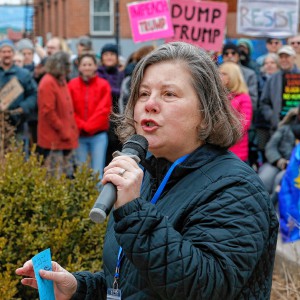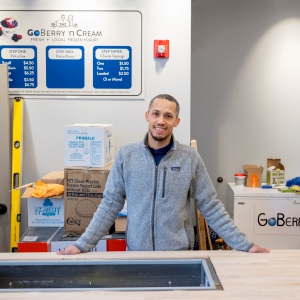Hadley school officials get geothermal primer from Smith College
|
Published: 08-21-2024 2:59 PM
Modified: 08-22-2024 11:12 AM |
NORTHAMPTON — Hadley school leaders got an up-close look at Smith College’s geothermal project on Monday, as the school district explores the possibility of adapting the technology for heating and cooling its own Hopkins Academy.
Announced originally in 2022, Smith’s six-year, $220 million geothermal project aims to make the campus fully carbon neutral by the year 2030. The geothermal project uses a series of wells that descend 800 feet into the ground in a closed loop. Fluid sent through the pipes either absorbs or discharges heat as it adjusts to the constant temperature at that depth, and is then transferred to a power plant on campus that uses heat pumps to extract either the cooling or the heat from the liquid and distributes it throughout the campus buildings.
Hadley school officials, including Superintendent Anne McKenzie, School Committee Chair Humera Fasihuddin and Business Manager Chris Desjardins, met with several overseers of the Smith project, including Matthew Tomaszewski, the college’s associate vice president of campus planning and sustainability, and project managers Bob Lambert and Gary Hartwell.
The group met together at the site of Smith’s first completed geothermal field, the Davis Lawn. The field is one of three fields the the school is constructing on campus, powering 20 student dorms as well as other buildings like Davis House and the Hills Chapel on the campus’s North District. A second geothermal field is currently underway on the campus’ Quad District, which will be followed by a third located in the center of campus.
In the basement beneath a building that hosts offices for Smith Botanical Garden staff, Hartwell showed the Hadley officials the energy center that controls the heating and cooling for the school’s North District. Pipes carrying either heated or chilled water run along the ceiling, with a control panel monitoring the temperature of the water along with the temperature it’s used to produce.
“It’s a thermal battery. The ground is just a big heat sink, and it happens to be 57 degrees,” Hartwell explained. “We’re just using that thermal energy to make chilled water or hot water — that’s what a heat pump does. And it can do it at the same time, which makes it really efficient.”
But school officials didn’t just ask about the inner workings of geothermal heating and cooling. There was also the issue of community engagement — how to get residents to support a project that may cause significant disruptions, with the loud noises of drilling 800 feet into the ground not far from where residents live?
“You’re going to have complaints. I mean, why wouldn’t you? This is disruptive,” Tomaszewski said. “We’ve found as long as you’re just open, honest and say, you know, this is what it is, empathize with individuals and say, here’s how much longer it’s going to take … I think what’s important is the forewarning, making sure people understand the bigger part, telling the story and what the benefit is overall, not just for your institution, but how that helps the community, how it helps the town.”
Article continues after...
Yesterday's Most Read Articles
 Five UMass Amherst students have visas, student status revoked
Five UMass Amherst students have visas, student status revoked
 State senators organize Trump defense: Comerford a leader on Response 2025 initiative
State senators organize Trump defense: Comerford a leader on Response 2025 initiative
 Long-vacant former Faces spot in Northampton gets new tenant
Long-vacant former Faces spot in Northampton gets new tenant
 ‘Delightful’ Northampton store shopping guide Jane Hertz, 88, seeking next gig
‘Delightful’ Northampton store shopping guide Jane Hertz, 88, seeking next gig
 Here come the sweetness: Four new businesses prepping to open in downtown Northampton
Here come the sweetness: Four new businesses prepping to open in downtown Northampton
 Local ‘Hands Off!’ standouts planned as part of national effort
Local ‘Hands Off!’ standouts planned as part of national effort
The planned geothermal project for Hopkins Academy is much smaller in scale than at Smith, with only Hopkins Academy being considered for a change in its heating and cooling system. But both Fasihuddin and McKenzie told the Gazette they benefited greatly from seeing the Smith project in action.
“This helped us a great deal with not only having us visually see what it looks like, giving us a tremendous amount of technical information, but also helped us with the kinds of things that at the front end when you’re looking at dollars and cents,” McKenzie said.
“We talked about community engagement, particularly around communicating cost avoidance, cost savings and financial incentives. But this idea of just straight noise, that was really important to hear about how you talk with people and be thinking through these things that impact the community.”
Like the Smith geothermal project, Hadley officials hope to have their geothermal project completed by around 2028. The town’s School Committee has chosen Clough, Harbour & Associates LLP of Boston to handle the project. The committee is aiming for a $900,000 total cost for the Hadley installation, which is currently in the design phase. Fasihuddin said Wednesday that the tour of Smith had been “incredibly informative” in determining the kind of geothermal system Hopkins Academy would need.
“We’re gonna bring this back to the rest of the School Committee after we digest it, and meet with our designers to see how what we learned fits in with what their thinking is,” Fasihuddin said.
Alexander MacDougall can be reached at amacdougall@gazettenet.com.










 Photo: Spring calling
Photo: Spring calling A father’s dream to be the best: Twelve men graduate from Nurturing Fathers program
A father’s dream to be the best: Twelve men graduate from Nurturing Fathers program
